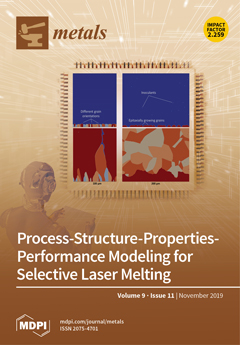In this study, the CoCrAlYTa-10%Al
2O
3 coatings were prepared by the high-velocity oxygen-fuel (HVOF) spraying. A series of ball-on-disk sliding wear tests were conducted to evaluate the tribological properties of the coatings at different temperatures (25 °C, 200 °C, 400 °C,
[...] Read more.
In this study, the CoCrAlYTa-10%Al
2O
3 coatings were prepared by the high-velocity oxygen-fuel (HVOF) spraying. A series of ball-on-disk sliding wear tests were conducted to evaluate the tribological properties of the coatings at different temperatures (25 °C, 200 °C, 400 °C, and 600 °C). The results showed that the average coefficients of friction (COFs) of the CoCrAlYTa-10%Al
2O
3 coatings were lower than that of H13 steel at different temperatures. The average COFs of the CoCrAlYTa-10%Al
2O
3 coatings and H13 steel both decreased with increasing temperature. The wear rate of the CoCrAlYTa-10%Al
2O
3 coatings increased first and then decreased. The microhardness of worn surface of the CoCrAlYTa-10%Al
2O
3 coatings increased with increasing temperature, while the microhardness of worn surface of H13 steel at 25 °C and 200°C was higher than that at 400 °C and 600 °C. The wear mechanism of the two materials was mainly abrasive wear. The tribofilms were formed on the worn surface of the CoCrAlYTa-10%Al
2O
3 coatings, which had a good protective effect. Due to thermal softening and low binding strength of debris, it was difficult for H13 steel to form the tribofilms. The wear rate of H13 steel was much higher than that of the CoCrAlYTa-10%Al
2O
3 coatings at 400 °C and 600 °C, indicating that the high temperature wear resistance of the coatings was much better than that of H13 steel.
Full article





